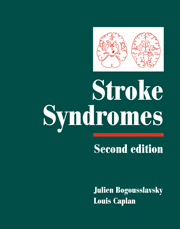Book contents
- Frontmatter
- Contents
- List of contributors
- Preface
- PART I CLINICAL MANIFESTATIONS
- PART II VASCULAR TOPOGRAPHIC SYNDROMES
- 29 Arterial territories of human brain
- 30 Superficial middle cerebral artery syndromes
- 31 Lenticulostriate arteries
- 32 Anterior cerebral artery
- 33 Anterior choroidal artery territory infarcts
- 34 Thalamic infarcts and hemorrhages
- 35 Caudate infarcts and hemorrhages
- 36 Posterior cerebral artery
- 37 Large and panhemispheric infarcts
- 38 Multiple, multilevel and bihemispheric infarcts
- 39 Midbrain infarcts
- 40 Pontine infarcts and hemorrhages
- 41 Medullary infarcts and hemorrhages
- 42 Cerebellar stroke syndromes
- 43 Extended infarcts in the posterior circulation (brainstem/cerebellum)
- 44 Border zone infarcts
- 45 Classical lacunar syndromes
- 46 Putaminal hemorrhages
- 47 Lobar hemorrhages
- 48 Intraventricular hemorrhages
- 49 Subarachnoid hemorrhage syndromes
- 50 Brain venous thrombosis syndromes
- 51 Carotid occlusion syndromes
- 52 Cervical artery dissection syndromes
- 53 Syndromes related to large artery thromboembolism within the vertebrobasilar system
- 54 Spinal stroke syndromes
- Index
- Plate section
34 - Thalamic infarcts and hemorrhages
from PART II - VASCULAR TOPOGRAPHIC SYNDROMES
Published online by Cambridge University Press: 17 May 2010
- Frontmatter
- Contents
- List of contributors
- Preface
- PART I CLINICAL MANIFESTATIONS
- PART II VASCULAR TOPOGRAPHIC SYNDROMES
- 29 Arterial territories of human brain
- 30 Superficial middle cerebral artery syndromes
- 31 Lenticulostriate arteries
- 32 Anterior cerebral artery
- 33 Anterior choroidal artery territory infarcts
- 34 Thalamic infarcts and hemorrhages
- 35 Caudate infarcts and hemorrhages
- 36 Posterior cerebral artery
- 37 Large and panhemispheric infarcts
- 38 Multiple, multilevel and bihemispheric infarcts
- 39 Midbrain infarcts
- 40 Pontine infarcts and hemorrhages
- 41 Medullary infarcts and hemorrhages
- 42 Cerebellar stroke syndromes
- 43 Extended infarcts in the posterior circulation (brainstem/cerebellum)
- 44 Border zone infarcts
- 45 Classical lacunar syndromes
- 46 Putaminal hemorrhages
- 47 Lobar hemorrhages
- 48 Intraventricular hemorrhages
- 49 Subarachnoid hemorrhage syndromes
- 50 Brain venous thrombosis syndromes
- 51 Carotid occlusion syndromes
- 52 Cervical artery dissection syndromes
- 53 Syndromes related to large artery thromboembolism within the vertebrobasilar system
- 54 Spinal stroke syndromes
- Index
- Plate section
Summary
Introduction
The thalamus is a large ovoid structure composed of several groups of grey-matter nuclei. The right and left thalami are strategically located at the top of the brainstem and act to provide a key relay to and from the cerebral cortex. Because of its complex anatomy and vascularization, the thalamus can give rise to a great variety of hemorrhagic and ischemic stroke syndromes. These various syndromes are characterized by prototypic clinical findings and abnormalities revealed by imaging that allow clinicians to locate an infarct in one of the thalamic nuclear groups and to infer the identity of the occluded artery and the pathogenesis of the stroke.
Blood supply to the thalamus
Knowledge of the vascular anatomy and supply zones of the thalamus is mandatory if one is to understand the clinical findings in patients with thalamic infarcts and hemorrhages. The thalamus receives most of its blood supply from four arterial pedicles that arise from the basilar artery bifurcation, the posterior communicating artery (PCoA), and the proximal portions of the posterior cerebral arteries (PCA) (Fig. 34.1).
Polar artery
The polar artery (also called the tuberothalamic, anterior internal optic: Duret (1874), or premamillary pedicle: Foix & Hillemand (1925a) usually arises from the PCoA. In about one-third of hemispheres, the polar artery is missing, and its territory is supplied by the thalamic–subthalamic arteries from the same side (Percheron, 1976a). The polar artery supplies the anteromedial and anterolateral regions of the thalamus, including the reticular nucleus, the mamillothalamic tract, part of the ventral lateral nucleus, the dorsomedial nucleus, and the lateral aspect of the anterior thalamic pole (Percheron, 1976a). The anterior nucleus is not supplied by the polar artery.
- Type
- Chapter
- Information
- Stroke Syndromes , pp. 461 - 468Publisher: Cambridge University PressPrint publication year: 2001
- 7
- Cited by

